|
Composed in 2013, below is the story and photographs
of a remarkable project in the remote Upper Arun River Valley
of Nepal - the Upper Arun Valley Medicinal and Aromatic
Plant (MAP) project, a classic "teach a man to
fish" tale.
Meeting Karma:
In 2000-01, Dana and I lived for a year in
Kathmandu. During that time I did volunteer work for
The Mountain Institute (TMI), an American non-profit dedicated
to conserving mountain environments while improving the
quality of life for mountain peoples.
At one point TMI asked if I wanted to go on a two-week trek to
scout out the site for a new Nepali national park on the Jaljale
Himal, where forests of 34 of the 36 native varieties
of rhododendrons grow. This was an exploratory trek
with a group of Nepali men who worked for or contracted
with TMI. I was directed to go to a small, airport where
someone would meet me with my ticket. When I asked
how I would recognize him, I was told that he would recognize
me; I would be the only person there with a white face.
At the appointed time, I went to the little airport and waited
awkwardly while looking around for someone who looked like they
were looking for me. A beautiful, slight young
man approached and said "Rand, sir." After
a moment I realized he was talking to me. He said,
"My name is Karma. I have our tickets on Cosmic
Air." I knew immediately that everything would
be fine, and thus began a great adventure that led to my writing
this letter.
The Jaljale trek turned out to be more of a challenge than anticipated. One
man fell and broke about 4 dozen eggs he was carrying (which
inspired a giant omelet); we got lost; a snow storm buried
our tents; the trails were sometime vague, steep and icy;
we ran out of food and in one day had to drop 9,000 feet into
a valley in search of something to eat, a search that
produced a bag of sugar and a goat. I soon noticed that
Karma, who had been contracted for the trek, was always by my side,
and when we were descending a particularly steep and icy
trail, Karma gripped the back of my collar. I soon realized
that his main job was to bring me back alive.
As the trek went on, I became increasingly impressed with Karma. He
was intelligent, observant, thoughtful, diligent, reliable,
curious, courteous, and patient, traits not often found
in young men in Nepal. While the rest of the guys,
some regular TMI employees, were playing grab-ass or throwing
rocks at yaks, Karma was recording in a notebook what
he saw around him soil erosion, plant varieties, overgrazing,
harvesting of rhododendrons for firewood. When
we returned to Kathmandu, I told the TMI director what an exceptional
person Karma was and urged him to hire Karma as a TMI employee.
He did.
The Bhote People and our trek to the Upper Arun Valley:
Over the years, Karma and I stayed in touch. He regularly
invited Dana and me to go with him to his village in the
Upper Arun River Valley to meet his family and his people. The
Arun River enters Nepal from the Tibetan Plateau and flows
between Makalu and Kanchenjunga, the world's third and fifth
tallest mountains. The people of the Upper Arun
Valley belong to the Bhote ethnic group. Like
the Sherpas, they migrated from Tibet to Nepal 500 to 600
years ago, but unlike the Sherpas, they settled in the relatively
obscurity of the Upper Arun Valley next to the Tibetan border,
rather than on the route to Mt. Everest. The area
was closed to foreigners until 2003.
In 2007, the armed insurrection in the mountains of Nepal had
quieted, and we finally accepted Karma's invitation to walk with
him to Chyamtang, his village in the Upper Arun
an eight-day walk. Rather than hiring commercial porters to
carry our food, tents, etc., I asked Karma to find men from the
Upper Arun Valley who had come for work to Kathmandu
so that we could pay them to go home for a visit. Karma
had not been home for several years and his six-year-old
son Pemba had never seen Chyamtang. Pemba decided
to walk, or as it sometimes turned out, run with us.
The Upper Arun River Valley is stunning. After the
first three days we saw no other foreigners. The
trail, maintained only by local villagers, sometimes disappeared
under recent rockslides. We climbed over
a makeshift bridge made of sticks lashed together with vines. News
of Karma's arrival spread by word of mouth. As
we approached Chyamtang, we were greeted by Karma's family
and friends, dressed in their finest clothes and adorned
with heirloom necklaces of amber, coral, and jade.
Though culturally rich, the Bhote people of the Upper Arun are
very poor subsistence farmers with annual family incomes of about $125. In
a tough, rocky environment, they grow millet, maize,
barley and potatoes. Most farmers raise a few goats,
pigs or chickens. All work is done by hand, with
occasional aid from an ox. Food scarcity is a constant
problem, a problem that becomes acute with any crop failure. Slash
and burn agriculture is widely practiced. Poverty
driven deforestation and over harvest of wild medicinal
plants for sale in Tibet are serious problems, as are illiteracy
and lack of health care and sanitation.
Bhote people are Buddhist, but their Buddhism is mixed with ancient
pre-Buddhist beliefs. Shamans and lamas share responsibility
for mediating between the physical and metaphysical
worlds. They have a special observance to ward off
crop damaging hailstorms.
For a week we slept on wooden pallets in the smoky house of Karma's
brother, joining the life of the village and visiting other settlements nearby. It
was a fascinating and heartwarming time. When
we got ready to leave, so many people put garlands of flowers
around our necks that we could not walk.
The beginning of the MAP project:
On the way back down the Arun River Valley with Karma, we began
to ask "why not a project cultivating medicinal and aromatic
plants (MAP) for the Bhote people in the Upper Arun
such as Karma had started in another area of Nepal?" The
people are smart, industrious and used to working cooperatively. They
love and trust Karma. Though suffering from overharvesting,
medicinal and aromatic plants grow wild in the region. A virtually
limitless market exists among the Chinese and Tibetans just across the border
and beyond in China itself. And most importantly,
there is nothing Karma would rather do than bring a better
quality of life to his people, and he knows how to do it.
In 2008, Dana and I agreed to fund the first two years of the
Upper Arun River MAP project. In 2009 we brought Karma
to Washington for 5 weeks and arranged training visits for
him with a local native plant nursery, the Washington State University Agricultural
Experimental station, a large herbal plant company with facilities here,
and several small organic farms.
The MAP project:
In the Upper Arun from 2010 through 2013, Karma and his team trained
and supported 1,296 farm households in the propagation, cultivation
and harvesting of medicinal and aromatic plants, impacting
the lives of well over 5,000 people in remote mountain villages
several days walk from the nearest road. Nurseries have
been constructed, including shaded seedbeds and low bamboo and
clear plastic greenhouses. Women's groups, clubs, cooperatives
and multiple households are working together. TMI has distributed
seeds to participating households. 95% of the MAP trained
farmers continue to participate in the program, gradually
enlarging their cultivated areas. Of the 452 farmers
trained in MAP cultivation this year, 42% are women.
Earnings from MAP cultivation are accelerating because harvest
of most plants begins in the second or third year. In
2014, 350-400 of the early participants are expected to become
self-sufficient in their ability to produce and purchase
seeds. MAP farmers have more than doubled pre-MAP
income and some have increased pre-MAP income several-fold. Earnings
in 2014 are expected to increase 60 to 70% over 2013 levels. This
is a life-altering boost in a region where traditionally
families survived on an income of less than $125 a year.
Increased income from MAP cultivation has already precipitated
significant life changes in the project area. The added
income has increased food security in the Upper Arun Valley
and supports community water and sanitation projects. MAP
cultivation provides an alternative source of income for
young people who might otherwise migrate to the cities
or abroad in search of work. Farmers are now spending
MAP income on their children's education, sending them to
boarding schools and college.
Farmers are also using their higher incomes to purchase metal
roofing to replace bamboo mat roofing. The bamboo
mats require replacement every three to four years,
necessitating harvesting of the locally threatened bamboo species
that grows very slowly and is a source of food for the Red
Panda and Himalayan Bear. By using metal
roofs, the pressure on these species is reduced. MAP farming
has also provided an alternative source of income to the illegal
harvest and sale of timber to Tibet/ China apractice degrading to
local ecosystems. And, cultivated MAP products are
replacing the environmental damaging and unsustainable
harvesting of wild plants.
MAP income has also made possible the low-cost purchase of efficient
cook stoves brought to the Upper Arun by TMI to replace traditional open,
unventilated indoor cooking and heating fires. The new stoves
reduce unsustainable wood fuel harvesting by up to 50%,
often from wild rhododendrons, and decrease extremely unhealthy indoor
air pollution, a problem with which Dana and I became very
familiar when we trekked to the Upper Arun with Karma. TMI
is bringing an additional 200 cook stoves to the Upper Arun
in 2014.
In the picture below, Rinen Bhote sits next to her new cook stove,
supported by the old metal cooking frame.
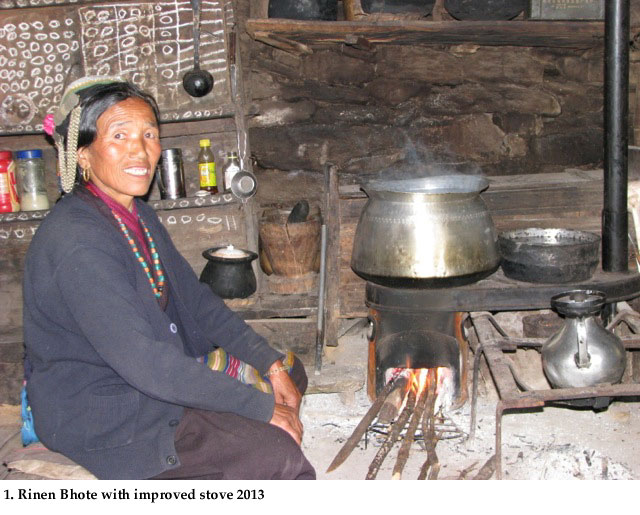
Fifty-four year old Rinen from the village of Pharang was widowed
20 years ago. All of her life she has depended
on traditional knowledge and hard farm labor to barely maintain
a subsistence livelihood. In 2012 she learned
of the MAP program. Though nervous about departing
from the traditional practices of village life in the Upper
Arun Valley, Rinen saw an opportunity to change her life and enrolled
in the MAP training program. She now cultivates several
MAP species on about a quarter acre of land.
Through TMI, she has used her MAP income
to purchase an efficient cook stove that is vented to the outside
and uses about half as much fuel as her traditional open
hearth cooking. Renin says that she is already healthier
because of the smoke-free environment in her home. Next
year she expects to earn enough from her MAP production
to pay for her 20-year-old daughter Ching Chippa's college
education, something unimaginable before the MAP project came
to the Upper Arun. For her earlier education, Ching
Chippa had to walk three hours a day; now she will be the first
person from the village of Pharang to get a college education. Rinen
says that the MAP project is a way to help empower women
economically.
Below are some photographs from Karma to help
you visualize MAP cultivation in the Upper Arun Valley.
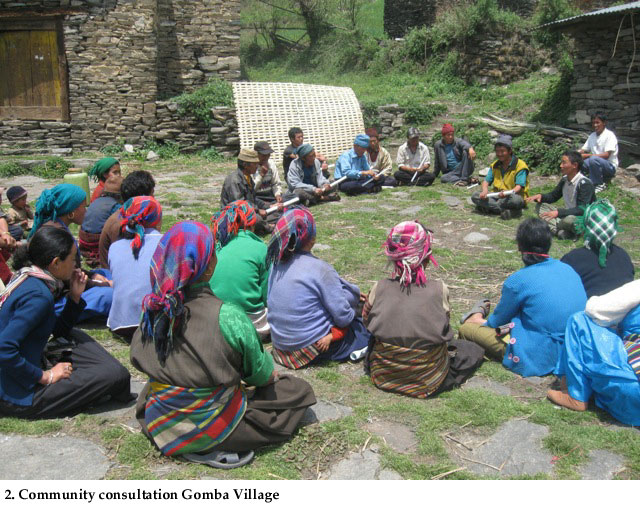
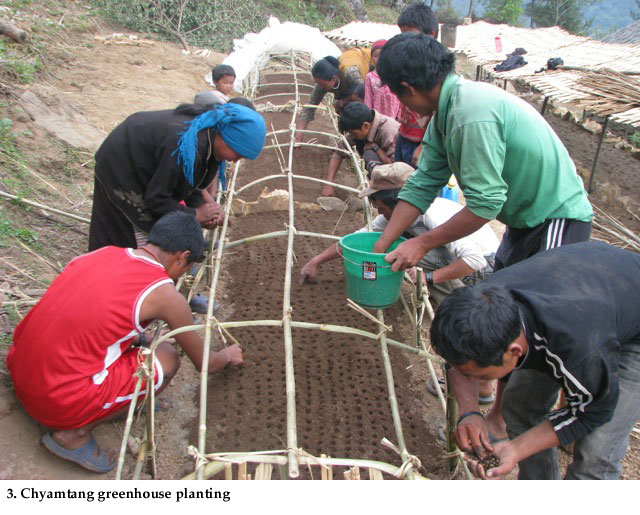


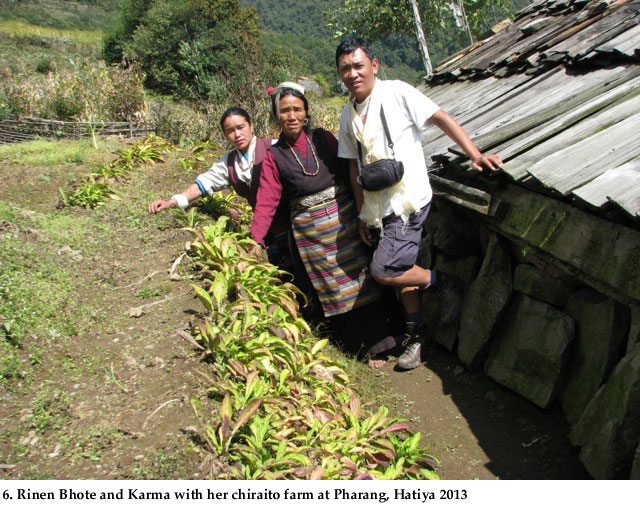

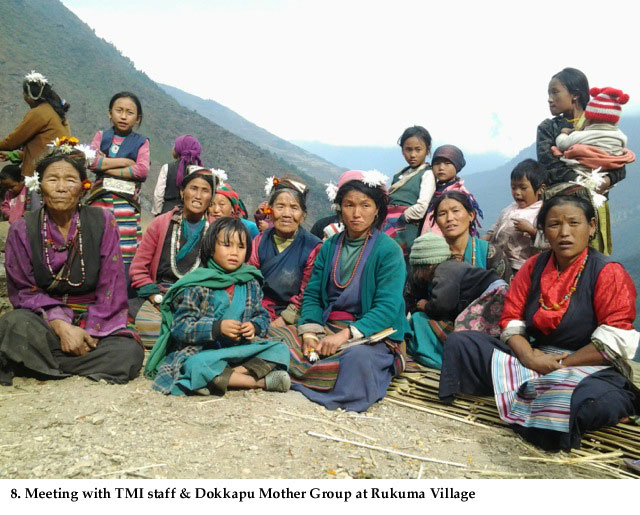
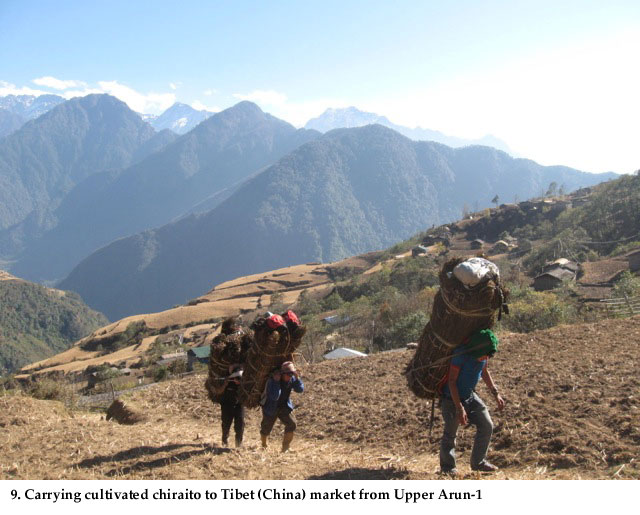
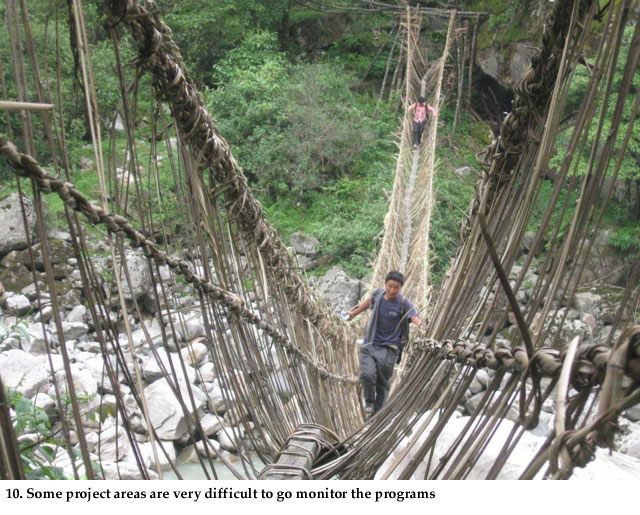

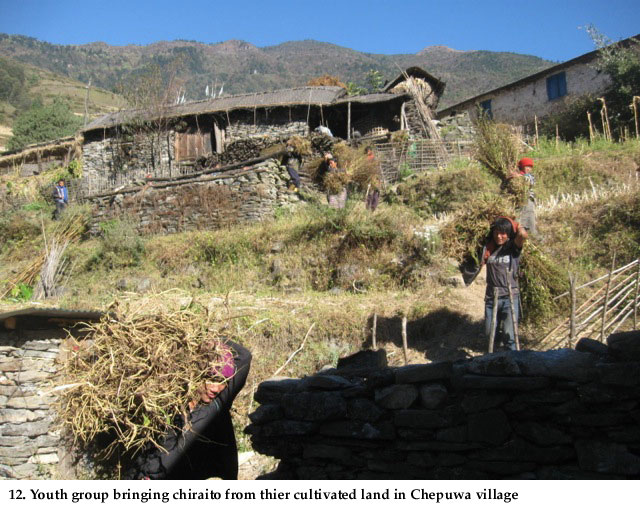
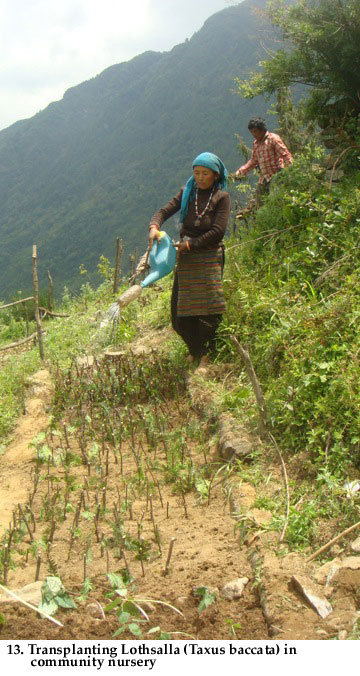
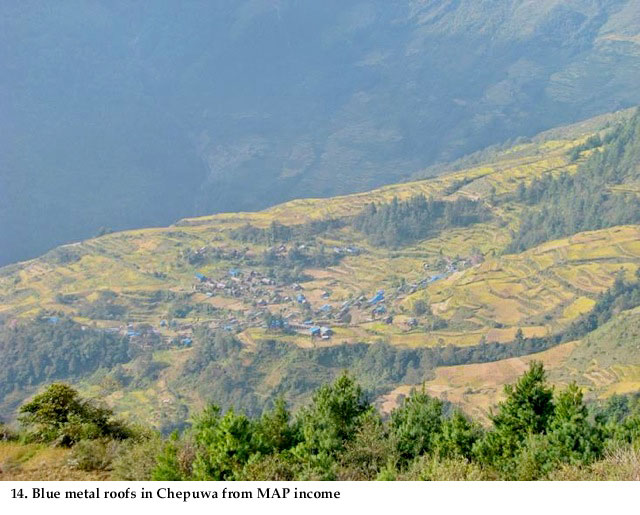
Support for the Upper Arun MAP project:
Dana and I continue to support the Upper Arun MAP program because
we believe we can do more good for our dollars here than we can anywhere
else we have ever seen. A relatively small amount
of money can significantly aid a fragile mountain environment and
make lasting changes in the lives of many people, including children
who otherwise would be frozen into a life with little opportunity
and considerable risks. People are learning skills that
will vastly increase their quality of life and that can be passed
down through generations. We know the people on the ground
doing the work and have complete confidence in their dedication,
frugality, competence and character.
Through contacts in Nepal and in the U.S. office of TMI, we are
able to monitor the work that is being done. This
October we will visit the Upper Arum MAP project. We feel
that it is a real privilege to participate in this adventure,
and I taken on responsibility to raise the money needed
to support the Upper Arun MAP project. With help from a
couple of friends and three small foundations, I have been
able to raise $40,000 to $45,000 annually for the
project for the past four years.
I have made arrangements with TMI that any money we donate or
that I raise will go directly to this project with nothing taken
out for TMI overhead. TMI is a U.S. 501(c)(3) organization,
so contributions are tax deductible.
Please let me know if you have questons about this wonderful
project. If you are interested in supporting the Upper Arun MAP
Project, please contact Rand Jack at randfjack@gmail.com
|













